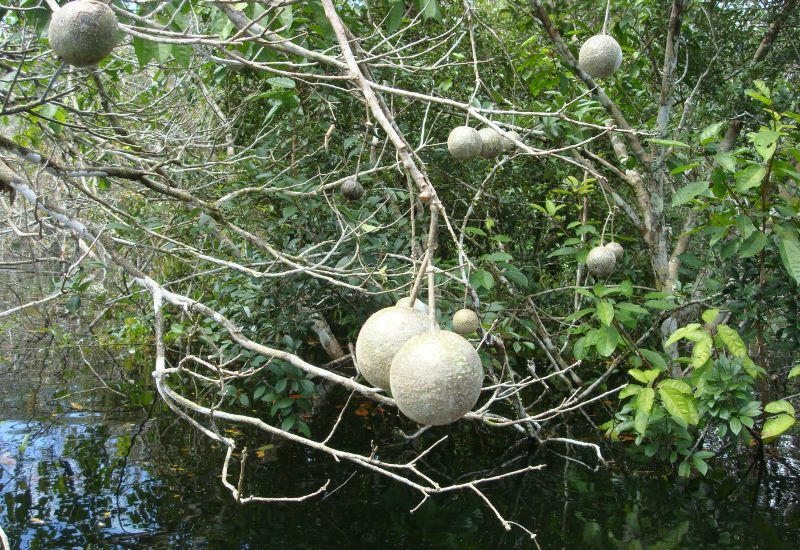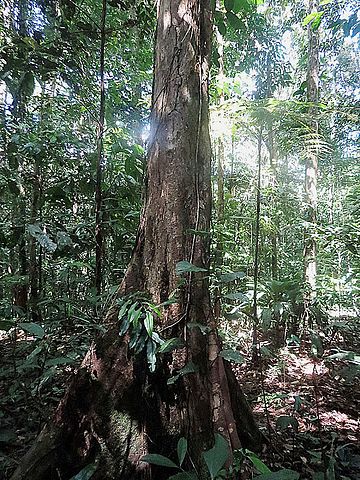


The crown of a catoré tree (Leonia glycycarpa) in fruiting. Listed as a hyperdominant species in the Amazon, it occurs mainly in flooded tropical forests (floodplains and igapó forests). During river floods, it completely loses its leaves and produces fruits that are eaten by fish (photo: Bruno Garcia Luize)
Published on 01/20/2025
By André Julião | Agência FAPESP – The vast majority of the approximately 46,000 species of tropical trees are extremely rare, representing no more than 10% of the individuals of the biome. On the other hand, half of the trees in the tropics belong to only 1,053 species (or 2.24%). The estimates were presented in an article published in the journal Nature, signed by an international consortium of researchers, including a Brazilian researcher supported by FAPESP.
“Dominant species play a fundamental role in the structure of the forest. They provide resources for other plants, fungi and animals. One of the study’s contributions was to point out a few species that represent a large proportion of the individuals. This allows us to make measurements and have more reliable statistics on how the ecosystem works,” explains Bruno Garcia Luize, who carried out the work as part of his post-doctoral studies at the Institute of Biology of the State University of Campinas (IB-UNICAMP), with a scholarship from FAPESP.
The authors used public databases on the composition of forest patches in the Amazon, Africa and Southeast Asia. These areas, usually one hectare in size, are called plots. Some of the Amazonian plots analyzed in the study were established and their data entered into the databases by Luize during his master’s degree at the National Institute of Amazonian Research (INPA), in Manaus, and his doctoral degree at the Institute of Biosciences of the São Paulo State University (IB-UNESP), in Rio Claro, also with a scholarship from FAPESP.
A total of 1,097 plots were analyzed in the Amazon, 368 in Africa and 103 in Southeast Asia, representing a sample of just over 1 million trees with a diameter of at least 10 centimeters in large forest massifs. Of the total number of trees, 93.3% were identified by species.
“In the Amazon, we’re well advanced in these collaborative forest inventory networks, which allow us to make these inferences and extrapolations. With data from other tropical forests, we now have a more global dimension,” says the researcher.
Hyperdominant species
In addition to determining the percentage of hyperdominant species, as those that make up half of the individuals in each tropical forest are called, the researchers were able to determine the names of those species that are most likely to be the most abundant in each of the areas analyzed.
In the Amazon, for example, some of the possible hyperdominant species identified were the matamatá (Eschweilera coriacea), which has thick bark and can reach 35 meters in height; two species of açaí (Euterpe oleracea and E. precatoria), known for its fruit and palm heart, which are widely consumed in Brazil; and the parapará (Jacaranda copaia), the only jacaranda species widely distributed in the Amazon.

Trees of the genus Eschweilera have been listed as possibly the most abundant species in the Amazon (photo: Dick Culbert/Wikimedia Commons)
Among Amazonian trees, hyperdominant trees account for 2.2% of species. The same proportions were observed in the rainforest-covered portion of the African continent, in the western, central and eastern parts (2.2% of species represent 50% of all trees), and in Southeast Asia, from Myanmar in the west to Sulawesi in the east (2.3%). The consistency in the proportion of hyperdominant species caught the researchers’ attention, as it indicates a reasonable number of species that could be better known in the short to medium term.
It is estimated that 299 species make up 50% of the 344 billion trees in the Amazon. In the tropical part of the African continent, 104 species make up half of the 113 billion tropical trees in closed canopies. In Southeast Asia, the researchers found that 278 species account for half of the 129 billion trees.
Luize points out that the study did not include other tropical forests, such as the Atlantic Rainforest and the Chocó Forest in South America, as well as data from Central America, New Guinea and Micronesia, which were not available at the time of the study. A more robust estimate will be possible when these regions are included, he says.
However, the researcher points out that the survey provides important clues about species that could be the focus of auto-ecological studies, which analyze how they interact with other species and the environment.
“Not to mention estimates of the carbon storage of these trees, which is essential information for calculating the emission and capture of greenhouse gases responsible for climate change,” he explains.
According to Simon Lewis, a professor at University College London and one of the coordinators of the study, focusing on a few hundred common trees, rather than the thousands of species about which almost nothing is known, could open up new ways of understanding tropical forests.
“This isn’t to deny the importance of rare species. They need special attention to be protected. However, rapid and important gains in knowledge should come from research on the more common species,” the researcher said in a press release.
The work, coordinated by researchers from the British university, has 356 authors. In addition to Luize, scientists from INPA, the National Institute for Space Research (INPE), the University of São Paulo (USP) and UNICAMP, as well as federal and state universities and research institutes in the Amazonian states and other regions of Brazil participated.
The article “Consistent patterns of common species across tropical tree communities” can be read at: www.nature.com/articles/s41586-023-06820-z.
Source: https://agencia.fapesp.br/53727